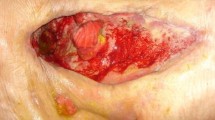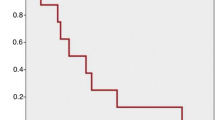Abstract
Background
We aimed to study outcome in patients with an open abdomen in whom the abdominal vacuum-assisted closure system (V.A.C.® Therapy™) was used to provide temporary cover and achieve wound closure.
Methods
All patients in whom V.A.C. Therapy was used to manage laparotomy wounds between February 2006 and May 2007 at a University Teaching Hospital were followed up prospectively until successful completion or stoppage of V.A.C. Therapy.
Results
Of the 51 consecutive patients (33 male), V.A.C. Therapy was used to manage a laparostomy in 10 patients and abdominal wound dehiscence in 41. Median (IQR) duration of V.A.C. Therapy was 17 (7–26) days. Wound healing was achieved in 31 (61%) patients, four of whom had additional surgery to assist wound closure. The rest healed by secondary intention. Treatment was withdrawn due to therapy-related complications in nine patients and due to medical or logistical reasons in seven. Four patients died while on therapy. While most V.A.C. Therapy-related problems were minor, two patients developed enteric fistulae that necessitated surgical repair. At a median (IQR) follow-up of 8 (4–13) months, 18 patients had stable cutaneous coverage with no incisional hernia, 12 developed an incisional hernia, 9 were lost to follow-up, and 12 died.
Conclusions
V.A.C. Therapy is a useful adjunct in the management of the open abdomen and should be considered in the treatment of this problem. Restoration of cutaneous and fascial integrity of the abdominal wall, the risk of fistulisation, and the cost-effectiveness of this therapy require further evaluation.

Similar content being viewed by others
References
Fernandez L, Norwood S, Roettger R et al (1996) Temporary intravenous bag silo closure in severe abdominal trauma. J Trauma 40:258–260
Mayberry JC, Mullins RJ, Crass RA et al (1997) Prevention of abdominal compartment syndrome by absorbable mesh prosthesis closure. Arch Surg 132:957–961
Nagy KK, Fildes JJ, Mahr C et al (1996) Experience with three prosthetic materials in temporary abdominal wall closure. Am Surg 62:331–335
Akers DL Jr, Fowl RJ, Kempczinski RF et al (1991) Temporary closure of the abdominal wall by use of silicone rubber sheets after operative repair of ruptured abdominal aortic aneurysms. J Vasc Surg 14:48–52
Mizrahi S, Deutsch M, Hayes D et al (1993) Improved zipper closure of the abdominal wall in patients requiring multiple intra-abdominal operations. Am J Surg 166:62–63
Barker DE, Kaufman HJ, Smith LA et al (2000) Vacuum pack technique of temporary abdominal closure: a 7-year experience with 112 patients. J Trauma 48:201–206
Fabian TC, Croce MA, Pritchard FE et al (1994) Planned ventral hernia. Staged management for acute abdominal wall defects. Ann Surg 219:643–650; discussion 651–653
Argenta LC, Morykwas MJ (1997) Vacuum-assisted closure: a new method for wound control and treatment: clinical experience. Ann Plast Surg 38:563–576; discussion 577
Morykwas MJ, Argenta L, Shelton-Brown EI et al (1997) Vacuum-assisted closure: a new method for wound control and treatment: animal studies and basic foundation. Ann Plast Surg 38:553–562
Stawicki SP, Schwarz NS, Schrag SP et al (2007) Application of vacuum-assisted therapy in postoperative ascitic fluid leaks: an integral part of multimodality wound management in cirrhotic patients. J Burns Wounds 6:e7
Cro C, George KJ, Donnelly J et al (2002) Vacuum-assisted closure system in the management of enterocutaneous fistulae. Postgrad Med J 78:364–365
Draus JM Jr, Huss SA, Harty NJ et al (2006) Enterocutaneous fistula: are treatments improving? Surgery 140:570–576; discussion 576–578
Suliburk JW, Ware DN, Balogh Z et al (2003) Vacuum-assisted wound closure achieves early fascial closure of open abdomens after severe trauma. J Trauma 55:1155–1160; discussion 1160–1161
Heller L, Levin SL, Butler CE (2006) Management of abdominal wound dehiscence using vacuum assisted closure in patients with compromised healing. Am J Surg 191:165–172
Perez D, Wildi S, Demartines N et al (2007) Prospective evaluation of vacuum-assisted closure in abdominal compartment syndrome and severe abdominal sepsis. J Am Coll Surg 205:586–592
Cipolla J, Stawicki SP, Hoff WS et al (2005) A proposed algorithm for managing the open abdomen. Am Surg 71:202–207
Banwell PE, Téot L (2003) Topical negative pressure (TNP): the evolution of a novel wound therapy. J Wound Care 12:22–28
Stone PA, Hass SM, Flaherty SK et al (2004) Vacuum-assisted fascial closure for patients with abdominal trauma. J Trauma 57:1082–1086
Barker DE, Green JM, Maxwell RA et al (2007) Experience with vacuum-pack temporary abdominal wound closure in 258 trauma and general and vascular surgical patients. J Am Coll Surg 204:784–792; discussion 792–793
Miller PR, Meredith JW, Johnson JC et al (2004) Prospective evaluation of vacuum-assisted fascial closure after open abdomen: planned ventral hernia rate is substantially reduced. Ann Surg 239:608–614; discussion 614–616
Petersson U, Acosta S, Björck M (2007) Vacuum-assisted wound closure and mesh-mediated fascial traction - a novel technique for late closure of the open abdomen. World J Surg 31:2133–2137
Cothren CC, Moore EE, Johnson JL et al (2006) One hundred percent fascial approximation with sequential abdominal closure of the open abdomen. Am J Surg 192:238–242
Mayberry JC, Burgess EA, Goldman RK et al (2004) Enterocutaneous fistula and ventral hernia after absorbable mesh prosthesis closure for trauma: the plain truth. J Trauma 57:157–162; discussion 163
Rao M, Burke D, Finan PJ et al (2007) The use of vacuum-assisted closure of abdominal wounds: a word of caution. Colorectal Dis 9:266–268
Fansler RF, Taheri P, Cullinane C et al (1995) Polypropylene mesh closure of the complicated abdominal wound. Am J Surg 170:15–18
Erdmann D, Drye C, Heller L et al (2001) Abdominal wall defect and enterocutaneous fistula treatment with the vacuum-assisted closure (VAC) system. Plast Reconstr Surg 108:2066–2068
Navsaria PH, Bunting M, Omoshoro-Jones J et al (2003) Temporary closure of open abdominal wounds by the modified sandwich-vacuum pack technique. Br J Surg 90:718–722
Schein M (1990) Intestinal fistulas and the open management of the septic abdomen. Arch Surg 125:1516–1517
Mendes-Eastman S (1998) Negative pressure wound therapy. Plast Surg Nursing 18:27–37
Author information
Authors and Affiliations
Corresponding author
Rights and permissions
About this article
Cite this article
Subramonia, S., Pankhurst, S., Rowlands, B.J. et al. Vacuum-Assisted Closure of Postoperative Abdominal Wounds: A Prospective Study. World J Surg 33, 931–937 (2009). https://doi.org/10.1007/s00268-009-9947-z
Published:
Issue Date:
DOI: https://doi.org/10.1007/s00268-009-9947-z




